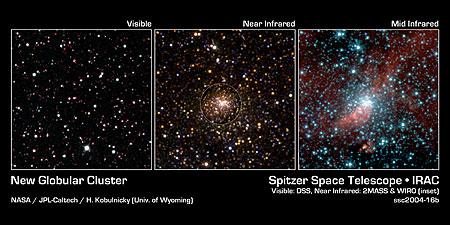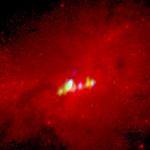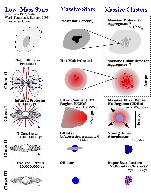Massive Stars & Star Cluster Research Summary

 Wyoming graduate student Andy Monson led the discovery of a new globuar star cluster
hidden beneath the gas and dust layers of our own Milky Way galaxy
(
Kobulnicky et al. 2004 ).
Just when astronomers thought they might have dug up the last of our
galaxy's "fossils," we've discovered a new one in the Galactic
equivalent of our own backyard.
Called globular clusters, these ancient bundles of stars date back to
the birth of our Milky Way galaxy, 13 or so billion years ago. They
are sprinkled around the center of the galaxy like seeds in a
pumpkin. Astronomers use clusters as tools for studying the Milky
Way's age and formation.
New infrared images from NASA's Spitzer Space Telescope and the
University of Wyoming Infrared Observatory reveal a never-before-seen
globular cluster within the dusty confines of the Milky Way.
The newfound cluster is one of about 150 known to orbit the center of
the Milky Way. These tightly packed knots of stars are among the
oldest objects in our galaxy, having formed about 10 to 13 billion
years ago. They contain several hundred thousand stars, most of which
are older and less massive than our Sun.
Follow-up observations with the University of Wyoming Infrared
Observatory helped set the distance of the new cluster at about 9,000
light-years from Earth -- closer than most clusters -- and set the
mass at the equivalent of 300,000 Suns. The cluster's apparent size,
as viewed from Earth, is comparable to a grain of rice held at arm's
length. It is located in the constellation Aquila.
This discovery was featured by a
Spitzer Space Telescope
Press Release and on
Astronomy Picture of the Day
Wyoming graduate student Andy Monson led the discovery of a new globuar star cluster
hidden beneath the gas and dust layers of our own Milky Way galaxy
(
Kobulnicky et al. 2004 ).
Just when astronomers thought they might have dug up the last of our
galaxy's "fossils," we've discovered a new one in the Galactic
equivalent of our own backyard.
Called globular clusters, these ancient bundles of stars date back to
the birth of our Milky Way galaxy, 13 or so billion years ago. They
are sprinkled around the center of the galaxy like seeds in a
pumpkin. Astronomers use clusters as tools for studying the Milky
Way's age and formation.
New infrared images from NASA's Spitzer Space Telescope and the
University of Wyoming Infrared Observatory reveal a never-before-seen
globular cluster within the dusty confines of the Milky Way.
The newfound cluster is one of about 150 known to orbit the center of
the Milky Way. These tightly packed knots of stars are among the
oldest objects in our galaxy, having formed about 10 to 13 billion
years ago. They contain several hundred thousand stars, most of which
are older and less massive than our Sun.
Follow-up observations with the University of Wyoming Infrared
Observatory helped set the distance of the new cluster at about 9,000
light-years from Earth -- closer than most clusters -- and set the
mass at the equivalent of 300,000 Suns. The cluster's apparent size,
as viewed from Earth, is comparable to a grain of rice held at arm's
length. It is located in the constellation Aquila.
This discovery was featured by a
Spitzer Space Telescope
Press Release and on
Astronomy Picture of the Day
 Short-lived, massive stars are the dominant source of ionizing photons,
mechanical energy, and heavy element nucleosynthesis in galaxies. Most
massive stars form in compact clusters just a few pc in size. We have
located what we believe are the youngest stages of massive
cluster formation in the form of ultra-dense HII regions in nearby
galaxies (
Kobulnicky & Johnson 1999,
). These often optically-obscured super
clusters are the few x10^5 year-old precursors to super
starclusters and globular clusters. We've identified a population of
radio-bright young star clusters in nearby galaxies like M 33 and NGC 6946 (
Johnson, Kobulnicky, Massey, & Conti (2001) ) and
Haro 3 (
Johnson, Indebetouw, Watson & Kobulnicky (2004) )
They provide a glimpse of the
earliest stages of massive star formation. We are currently
undertaking a comprehensive radio, millimeter-wave, and infrared
observational program to conduct a census of extremely young massive
clusters and understand their formation mechanisms. Our goal is to chronicle the
formative stages of very young massive star clusters and fill in the unknown
phases of the schematic diagram shown below.
Short-lived, massive stars are the dominant source of ionizing photons,
mechanical energy, and heavy element nucleosynthesis in galaxies. Most
massive stars form in compact clusters just a few pc in size. We have
located what we believe are the youngest stages of massive
cluster formation in the form of ultra-dense HII regions in nearby
galaxies (
Kobulnicky & Johnson 1999,
). These often optically-obscured super
clusters are the few x10^5 year-old precursors to super
starclusters and globular clusters. We've identified a population of
radio-bright young star clusters in nearby galaxies like M 33 and NGC 6946 (
Johnson, Kobulnicky, Massey, & Conti (2001) ) and
Haro 3 (
Johnson, Indebetouw, Watson & Kobulnicky (2004) )
They provide a glimpse of the
earliest stages of massive star formation. We are currently
undertaking a comprehensive radio, millimeter-wave, and infrared
observational program to conduct a census of extremely young massive
clusters and understand their formation mechanisms. Our goal is to chronicle the
formative stages of very young massive star clusters and fill in the unknown
phases of the schematic diagram shown below.

 The evolutionary path of massive stars is sensitive to the presence of
close binary companions. However, very little is known about the
companions of early type stars. Population synthesis studies of double
neutron star systems predict formation rates one to two orders of
magnitude greater than the rate inferred from the observations. This
discrepancy can be explained, in part, by the choice of the mass ratio
distribution, P(q), for massive stars. Mergers of these binary
systems are the most promising sources of gamma-ray bursts and
gravitational wave emission. The (unknown) fraction of massive close
binaries has a large effect on the predicted spectral energy
distribution used in modeling starburst populations in the local and
high redshift universe. We are engaged in a long-term program to
measure the binary mass fraction and binary mass ratio distribution for
massive stars in the Milky Way using radial velocity and astrometric
measurements from the Keck, Lick, WIYN, and
WIRO observatories.
The evolutionary path of massive stars is sensitive to the presence of
close binary companions. However, very little is known about the
companions of early type stars. Population synthesis studies of double
neutron star systems predict formation rates one to two orders of
magnitude greater than the rate inferred from the observations. This
discrepancy can be explained, in part, by the choice of the mass ratio
distribution, P(q), for massive stars. Mergers of these binary
systems are the most promising sources of gamma-ray bursts and
gravitational wave emission. The (unknown) fraction of massive close
binaries has a large effect on the predicted spectral energy
distribution used in modeling starburst populations in the local and
high redshift universe. We are engaged in a long-term program to
measure the binary mass fraction and binary mass ratio distribution for
massive stars in the Milky Way using radial velocity and astrometric
measurements from the Keck, Lick, WIYN, and
WIRO observatories.
Back to Chip's Homepage





